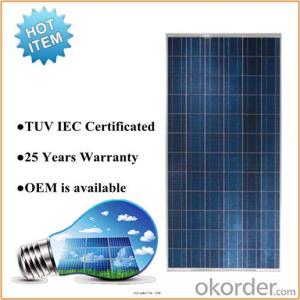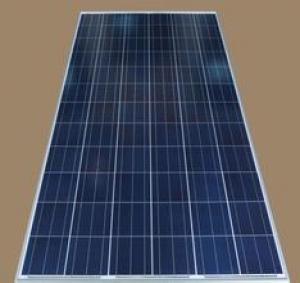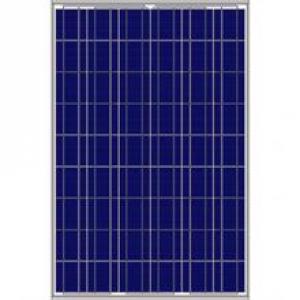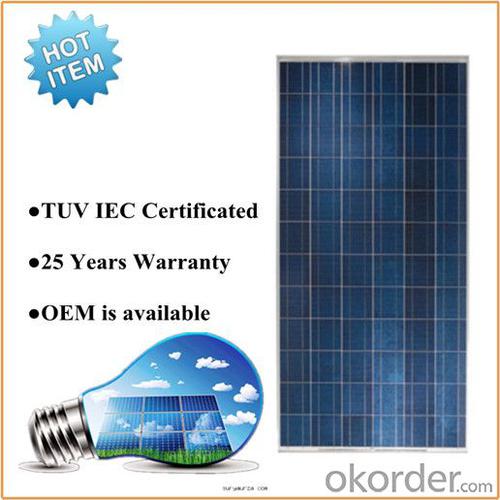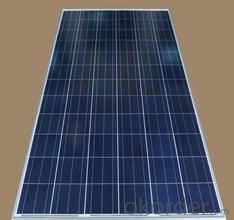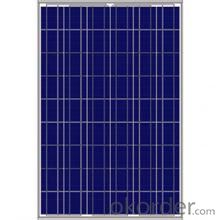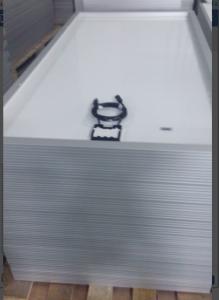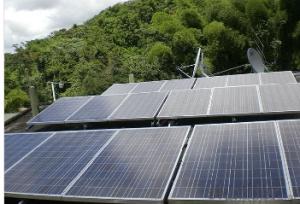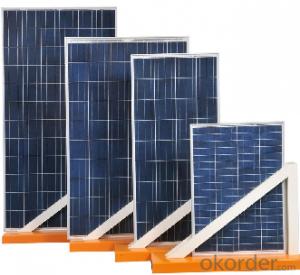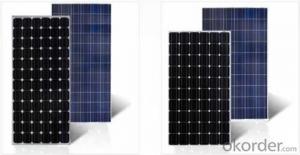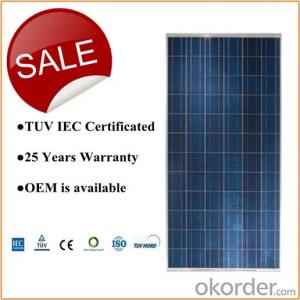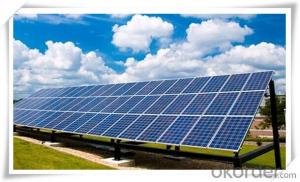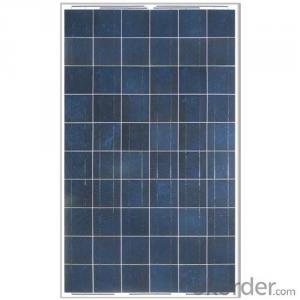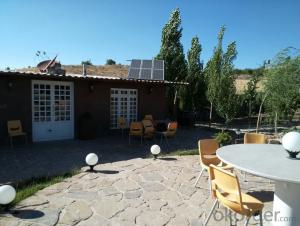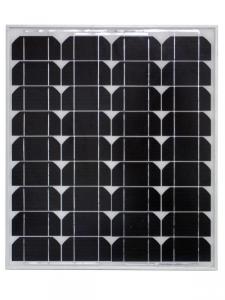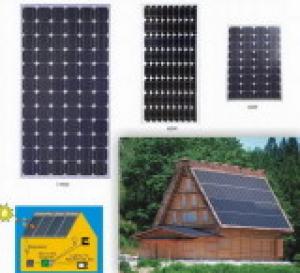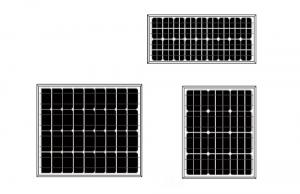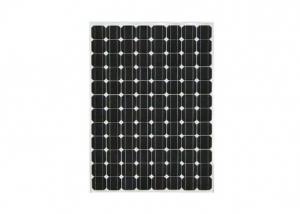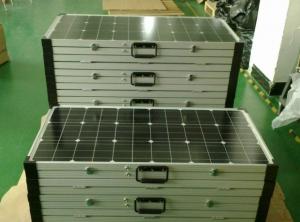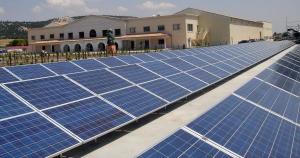Juno Solar Panels Poly 270W with TUV, IEC, CE
- Loading Port:
- Ningbo
- Payment Terms:
- TT or LC
- Min Order Qty:
- -
- Supply Capability:
- 600MW Annual year watt/month
OKorder Service Pledge
OKorder Financial Service
You Might Also Like
Competitive Prices 270w Poly Solar Panels from China Manufacturer
Solar Panel 270w with Good Quality and Warranty
Mechanical Characteristics
Cell Type | Poly Crystalline 156×156mm(6 inch) |
No. of Cells | 72(6×12) |
Dimension | 1950×992×50mm |
Weight | 23kg |
Component element
Front Glass | 3.2mm, High Transmission, Low Iron, Tempered Glass |
Frame | Anodized Aluminum Alloy Type 6063-T5 |
Junction Box | IP 65 Rated (Black) |
Output Cables | TUV 1×4mm2, length:900mm |
Connector | MC4(UV resistance and self-locking/IP67) |
Encapsulation Material | EVA(0.50±0.03mm thickness) |
Back Foil | White TPT(0.32±0.03mm thickness) |
Fixing Adhesive | Silicone Sealant(White) |
Specifications
Module Type | NBJ-270P | NBJ-280P | NBJ-290P | NBJ-300P |
Maximum Power at STC (Pmax) | 270Wp | 280Wp | 290Wp | 300Wp |
Maximum Power Voltage (Vmp) | 36.21V | 36.38V | 36.50V | 36.60V |
Maximum Power Current (Imp) | 7.46A | 7.61A | 7.95A | 8.20A |
Open-circuit Voltage (Voc) | 43.50V | 43.70V | 43.95V | 44.30V |
Short-circuit Current (Isc) | 7.98A | 8.24A | 8.50A | 8.77A |
Cell Efficiency (%) | 15.7% | 16.3% | 16.9% | 17.2% |
Module Efficiency (%) | 14% | 14.5% | 15.0% | 15.5% |
Operating Temperature( °C ) | -40°C ~+90°C | |||
Maximum System Voltage(V) | DC 1000V(TUV) / DC600V(UL) | |||
Maximum Rated Current Series(A) | 15A | |||
Power Tolerance | 0~+3% | |||
Temperature Coefficients of Pmax | (-0.45±0.05)%/°C | |||
Temperature Coefficients of Voc | (0.05±0.01) %/°C | |||
Temperature Coefficients of Isc | (-0.35±0.02)%/°C | |||
NOTC(°C ) | (47±2)°C | |||
STC: Irradiance 1000W/M2 Module Temperature: 25°C AM=1.5
Warranty
Warranty | 10-year warranty on product material and processing technology |
Industry power output warranty: 90% in 12 years, 80% in 25 years |
Packing Configuration
Q’ty/Pallet, | 1×20’ft | 1×40’GP | 1×40’HQ |
Pallet Q’ty | 5pallets | 11pallets | 11pallets |
Q’ty/Container | 200pcs | 440pcs | 495pcs |
Package

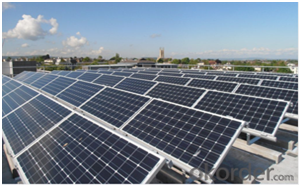
FAQ
I. Will you focus on the safety of the goods during transportation?
Yes, Safety of the cargo is the primary element that we would consider on transportation.
II..How would guarantee the quality will meet the requirements of your clients?
Before shipment, we will have inspection for each batch of goods.
III..What certificates do you have?
IEC,UL,TUV,CSA,etc.
IV..Can you do OEM according to clients’ requirements?
Yes, we have our own brand while we can provide OEM service.
- Q: How do solar panels affect the electricity bill?
- Solar panels can significantly reduce or even eliminate electricity bills by generating clean, renewable energy from the sun. When solar panels produce more electricity than a household consumes, the excess energy can be fed back into the grid, resulting in credits or monetary compensation. This process, known as net metering, allows homeowners to offset their electricity usage and potentially receive lower bills or even payments from their utility company.
- Q: What are the benefits of using solar panels?
- There are several benefits to using solar panels. Firstly, solar energy is a renewable source of energy, meaning it will never run out. It also produces clean energy, which reduces greenhouse gas emissions and helps combat climate change. Solar panels can help homeowners and businesses save money on their electricity bills by generating their own energy. Additionally, solar panels require minimal maintenance and have a long lifespan, making them a cost-effective investment in the long run. Finally, using solar panels can also contribute to energy independence, as it reduces reliance on traditional fossil fuels and centralized power grids.
- Q: Can solar panels be installed on walls?
- Yes, solar panels can be installed on walls. However, it is important to consider the orientation and angle of the wall to ensure maximum sunlight exposure for efficient energy generation. Additionally, the strength and stability of the wall should be evaluated to support the weight of the solar panels.
- Q: When you add a load resistor to a PV panel (Solar panel) of 00 ohms what happens to the voltage produced from the cellAlso, as the resistance increases, how does this affect the output voltage
- Look at the graph data that looks like a rotated L. That is what voltage as a function of current characteristically behaves. The highest voltage value is called open circuit voltage (Voc). The current at lowest voltage value is called short circuit current (Isc). If you notice, a second curve is plotted that looks like a hill. That curve is power output as a function of voltage. At the peak of said hill, you get the most utility of your PV module, as you output the maximum power possible, and that is the nameplate value for the PV module's power rating.
- Q: I have a home made 24 volt electric cart. It is powered by two 2Volt deep cycle batteries. Since the motor runs on 24 volts the batteries are wired in series to produce the 24 volts. I only have a 2 volt battery charger, but I also have two 2 volt solar panels. It is a pain having to unhook wires, rewire it, or charge them one at the time.HERE IS THE QUESTION REALLY... Can I wire the two 2 volt solar panels together in series (ie: negative to positive) then connect it to the existing 24 volt system and have it charge the batteries fine. I know basic wiring, but I know nearly nothing about solar panels, will it work fine? will it cause them to break? or short out?(additional info, the solar panels are only rated at 5 amps so it will not overcharge the batteries or anything)
- If the panels are the same, there is no problem in putting them in series. If you examine the panels, they will be made up of about 36 identical cells in series. Ok, now you have 72 cells in series, fine if they are the same. You need (at a minimum) a diode in the line so that when it is dark, the panels do not draw current out the batteries (it wont be much but you might as well block it). You say the panels are rated 5 amps? Those are pretty good sized panels! Unless you have a charging regulator, I guarantee that they Will overcharge the batteries (unless the batteries are huge, like the size of a refrigerator). Did you maybe mean 5 watts? About a foot square? If so, the output is about 300mA (0.3 amps) which will not overcharge a battery as long as it is at least as large as a garden tractor battery. At a 300mA charge rate, it will take a longgg time to recharge.
- Q: I've been figuring ways to keep water thawed out this winter, and this bucket seems to be the easiest thing. What kind of set up (solar panel) would I need to feed this 260 watt heated bucket?
- Unfortunately solar panels are low output,generally only 2 volt and very low amperage,so you would need to build a multi panel array with a DC-AC converter all together costing several hundred dollars which would only work during sunlight.Just roughly figuring,about $800. Plan2-Solar charger,battery bank,and DC-AC inverter so it would work 24hrs a day,also several hundred $$. Solar power does just not seem feasible(to me)in this application.By far the cheapest set up here would be an extension cord fromhouse to the bucket.260 watts per hr is a fairly lightweight draw,even not figuring the thermostat's cycling it on and off as needed.Electricity is sold in kilowatt hours(000W/hr).This bucket would use(not allowing for thermostats control lowering it)appx 6000watts or 6KW per day.Depending on your electrical cost per Kwh it would cost very little to run.(In my location appx 50cents a day) or appx the same amount as my computer(325watts total)) Note that that would be a maximum rate,and would actually be less due to thermostat cycling off and on as needed.
- Q: How do solar panels affect roof ventilation?
- Solar panels can have both positive and negative effects on roof ventilation. On one hand, solar panels can provide shade to the roof, reducing heat absorption and helping to keep the attic space cooler. This can decrease the need for excessive ventilation and potentially lead to energy savings. However, solar panels can also obstruct the airflow on the roof, limiting the natural ventilation and potentially causing heat buildup. Therefore, it is important to consider the design and placement of solar panels to ensure proper roof ventilation is maintained.
- Q: I am doing a science fair project on solar panels, and I need four solar panels to conduct the experiment. I would only need the solar panels for a week. What type of solar panel should I get?
- If okorder / for some ideas.
- Q: Can solar panels be installed on military bases or installations?
- Yes, solar panels can be installed on military bases or installations. In fact, many military bases around the world have already incorporated solar energy as a part of their sustainability initiatives. Installing solar panels on military bases not only helps reduce their reliance on traditional energy sources but also enhances their energy security and resilience.
- Q: i want to how i make solar panels
- For okorder /
Send your message to us
Juno Solar Panels Poly 270W with TUV, IEC, CE
- Loading Port:
- Ningbo
- Payment Terms:
- TT or LC
- Min Order Qty:
- -
- Supply Capability:
- 600MW Annual year watt/month
OKorder Service Pledge
OKorder Financial Service
Similar products
Hot products
Hot Searches
Related keywords
